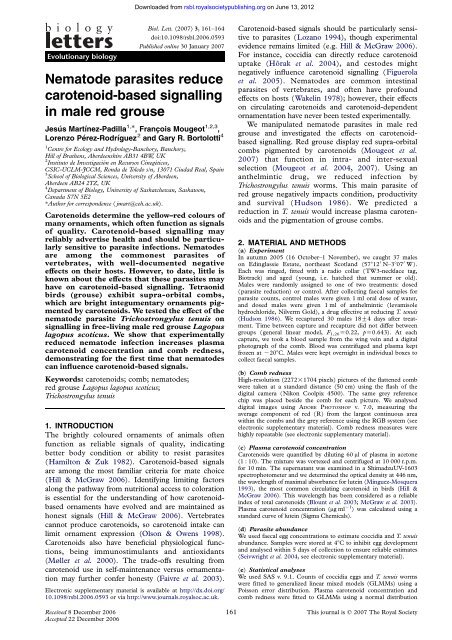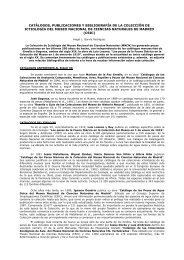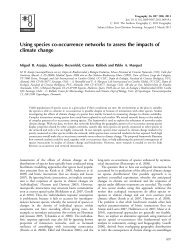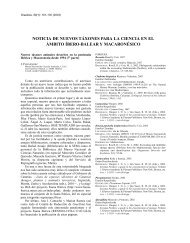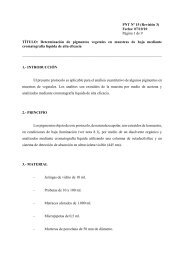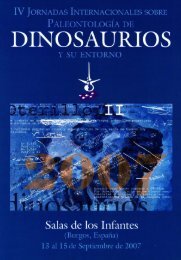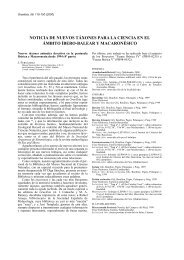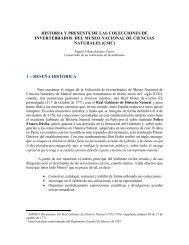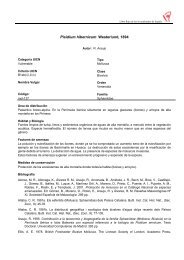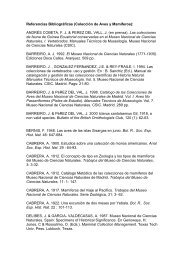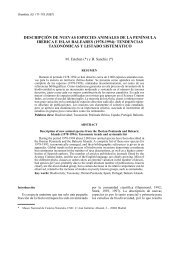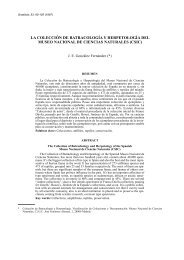Nematode parasites reduce carotenoid-based signalling in male red ...
Nematode parasites reduce carotenoid-based signalling in male red ...
Nematode parasites reduce carotenoid-based signalling in male red ...
You also want an ePaper? Increase the reach of your titles
YUMPU automatically turns print PDFs into web optimized ePapers that Google loves.
Downloaded from rsbl.royalsocietypublish<strong>in</strong>g.org on June 13, 2012Evolutionary biologyBiol. Lett. (2007) 3, 161–164doi:10.1098/rsbl.2006.0593Published onl<strong>in</strong>e 30 January 2007<strong>Nematode</strong> <strong>parasites</strong> <strong><strong>red</strong>uce</strong><strong>carotenoid</strong>-<strong>based</strong> <strong>signall<strong>in</strong>g</strong><strong>in</strong> <strong>male</strong> <strong>red</strong> grouseJesús Martínez-Padilla 1, *, François Mougeot 1,2,3 ,Lorenzo Pérez-Rodríguez 2 and Gary R. Bortolotti 41 Centre for Ecology and Hydrology-Banchory, Banchory,Hill of Brathens, Aberdeenshire AB31 4BW, UK2 Instituto de Investigación en Recursos C<strong>in</strong>egéticos,CSIC-UCLM-JCCM, Ronda de Toledo s/n, 13071 Ciudad Real, Spa<strong>in</strong>3 School of Biological Sciences, University of Aberdeen,Aberdeen AB24 2TZ, UK4 Department of Biology, University of Saskatchewan, Saskatoon,Canada S7N 5E2*Author for correspondence ( jmart@ceh.ac.uk).Carotenoids determ<strong>in</strong>e the yellow–<strong>red</strong> colours ofmany ornaments, which often function as signalsof quality. Carotenoid-<strong>based</strong> <strong>signall<strong>in</strong>g</strong> mayreliably advertise health and should be particularlysensitive to parasite <strong>in</strong>fections. <strong>Nematode</strong>sare among the commonest <strong>parasites</strong> ofvertebrates, with well-documented negativeeffects on their hosts. However, to date, little isknown about the effects that these <strong>parasites</strong> mayhave on <strong>carotenoid</strong>-<strong>based</strong> <strong>signall<strong>in</strong>g</strong>. Tetraonidbirds (grouse) exhibit supra-orbital combs,which are bright <strong>in</strong>tegumentary ornaments pigmentedby <strong>carotenoid</strong>s. We tested the effect of thenematode parasite Trichostrongylus tenuis on<strong>signall<strong>in</strong>g</strong> <strong>in</strong> free-liv<strong>in</strong>g <strong>male</strong> <strong>red</strong> grouse Lagopuslagopus scoticus. We show that experimentally<strong><strong>red</strong>uce</strong>d nematode <strong>in</strong>fection <strong>in</strong>creases plasma<strong>carotenoid</strong> concentration and comb <strong>red</strong>ness,demonstrat<strong>in</strong>g for the first time that nematodescan <strong>in</strong>fluence <strong>carotenoid</strong>-<strong>based</strong> signals.Keywords: <strong>carotenoid</strong>s; comb; nematodes;<strong>red</strong> grouse Lagopus lagopus scoticus;Trichostrongylus tenuis1. INTRODUCTIONThe brightly colou<strong>red</strong> ornaments of animals oftenfunction as reliable signals of quality, <strong>in</strong>dicat<strong>in</strong>gbetter body condition or ability to resist <strong>parasites</strong>(Hamilton & Zuk 1982). Carotenoid-<strong>based</strong> signalsare among the most familiar criteria for mate choice(Hill & McGraw 2006). Identify<strong>in</strong>g limit<strong>in</strong>g factorsalong the pathway from nutritional access to colorationis essential for the understand<strong>in</strong>g of how <strong>carotenoid</strong><strong>based</strong>ornaments have evolved and are ma<strong>in</strong>ta<strong>in</strong>ed ashonest signals (Hill & McGraw 2006). Vertebratescannot produce <strong>carotenoid</strong>s, so <strong>carotenoid</strong> <strong>in</strong>take canlimit ornament expression (Olson & Owens 1998).Carotenoids also have beneficial physiological functions,be<strong>in</strong>g immunostimulants and antioxidants(Møller et al. 2000). The trade-offs result<strong>in</strong>g from<strong>carotenoid</strong> use <strong>in</strong> self-ma<strong>in</strong>tenance versus ornamentationmay further confer honesty (Faivre et al. 2003).Electronic supplementary material is available at http://dx.doi.org/10.1098/rsbl.2006.0593 or via http://www.journals.royalsoc.ac.uk.Carotenoid-<strong>based</strong> signals should be particularly sensitiveto <strong>parasites</strong> (Lozano 1994), though experimentalevidence rema<strong>in</strong>s limited (e.g. Hill & McGraw 2006).For <strong>in</strong>stance, coccidia can directly <strong><strong>red</strong>uce</strong> <strong>carotenoid</strong>uptake (Hõrak et al. 2004), and cestodes mightnegatively <strong>in</strong>fluence <strong>carotenoid</strong> <strong>signall<strong>in</strong>g</strong> (Figuerolaet al. 2005). <strong>Nematode</strong>s are common <strong>in</strong>test<strong>in</strong>al<strong>parasites</strong> of vertebrates, and often have profoundeffects on hosts (Wakel<strong>in</strong> 1978); however, their effectson circulat<strong>in</strong>g <strong>carotenoid</strong>s and <strong>carotenoid</strong>-dependentornamentation have never been tested experimentally.We manipulated nematode <strong>parasites</strong> <strong>in</strong> <strong>male</strong> <strong>red</strong>grouse and <strong>in</strong>vestigated the effects on <strong>carotenoid</strong><strong>based</strong><strong>signall<strong>in</strong>g</strong>. Red grouse display <strong>red</strong> supra-orbitalcombs pigmented by <strong>carotenoid</strong>s (Mougeot et al.2007) that function <strong>in</strong> <strong>in</strong>tra- and <strong>in</strong>ter-sexualselection (Mougeot et al. 2004, 2007). Us<strong>in</strong>g ananthelm<strong>in</strong>tic drug, we <strong><strong>red</strong>uce</strong>d <strong>in</strong>fection byTrichostrongylus tenuis worms. This ma<strong>in</strong> parasite of<strong>red</strong> grouse negatively impacts condition, productivityand survival (Hudson 1986). We p<strong>red</strong>icted a<strong>red</strong>uction <strong>in</strong> T. tenuis would <strong>in</strong>crease plasma <strong>carotenoid</strong>sand the pigmentation of grouse combs.2. MATERIAL AND METHODS(a) ExperimentIn autumn 2005 (16 October–1 November), we caught 37 <strong>male</strong>son Ed<strong>in</strong>glassie Estate, northeast Scotland (57812 0 N–3807 0 W).Each was r<strong>in</strong>ged, fitted with a radio collar (TW3-necklace tag,Biotrack) and aged (young, i.e. hatched that summer or old).Males were randomly assigned to one of two treatments: dosed(parasite <strong>red</strong>uction) or control. After collect<strong>in</strong>g faecal samples forparasite counts, control <strong>male</strong>s were given 1 ml oral dose of water,and dosed <strong>male</strong>s were given 1 ml of anthelm<strong>in</strong>tic (levamisolehydrochloride, Nilverm Gold), a drug effective at <strong>red</strong>uc<strong>in</strong>g T. tenuis(Hudson 1986). We recaptu<strong>red</strong> 30 <strong>male</strong>s 18G4 days after treatment.Time between capture and recapture did not differ betweengroups (general l<strong>in</strong>ear model, F 1,26 Z0.22, pZ0.643). At eachcapture, we took a blood sample from the w<strong>in</strong>g ve<strong>in</strong> and a digitalphotograph of the comb. Blood was centrifuged and plasma keptfrozen at K208C. Males were kept overnight <strong>in</strong> <strong>in</strong>dividual boxes tocollect faecal samples.(b) Comb <strong>red</strong>nessHigh-resolution (2272!1704 pixels) pictures of the flattened combwere taken at a standard distance (50 cm) us<strong>in</strong>g the flash of thedigital camera (Nikon Coolpix 4500). The same grey referencechip was placed beside the comb for each picture. We analyseddigital images us<strong>in</strong>g ADOBE PHOTOSHOP v. 7.0, measur<strong>in</strong>g theaverage component of <strong>red</strong> (R) from the largest cont<strong>in</strong>uous areawith<strong>in</strong> the combs and the grey reference us<strong>in</strong>g the RGB system (seeelectronic supplementary material). Comb <strong>red</strong>ness measures werehighly repeatable (see electronic supplementary material).(c) Plasma <strong>carotenoid</strong> concentrationCarotenoids were quantified by dilut<strong>in</strong>g 60 ml of plasma <strong>in</strong> acetone(1 : 10). The mixture was vortexed and centrifuged at 10 000 r.p.m.for 10 m<strong>in</strong>. The supernatant was exam<strong>in</strong>ed <strong>in</strong> a ShimadzuUV-1603spectrophotometer and we determ<strong>in</strong>ed the optical density at 446 nm,the wavelength of maximal absorbance for lute<strong>in</strong> (Mínguez-Mosquera1993), the most common circulat<strong>in</strong>g <strong>carotenoid</strong> <strong>in</strong> birds (Hill &McGraw 2006). This wavelength has been conside<strong>red</strong> as a reliable<strong>in</strong>dex of total <strong>carotenoid</strong>s (Blount et al. 2003; McGraw et al. 2003).Plasma <strong>carotenoid</strong> concentration (mgml K1 ) was calculated us<strong>in</strong>g astandard curve of lute<strong>in</strong> (Sigma Chemicals).(d) Parasite abundanceWe used faecal egg concentrations to estimate coccidia and T. tenuisabundance. Samples were sto<strong>red</strong> at 48C to <strong>in</strong>hibit egg developmentand analysed with<strong>in</strong> 5 days of collection to ensure reliable estimates(Seivwright et al. 2004, see electronic supplementary material).(e) Statistical analysesWe used SAS v. 9.1. Counts of coccidia eggs and T. tenuis wormswere fitted to generalized l<strong>in</strong>ear mixed models (GLMMs) us<strong>in</strong>g aPoisson error distribution. Plasma <strong>carotenoid</strong> concentration andcomb <strong>red</strong>ness were fitted to GLMMs us<strong>in</strong>g a normal distributionReceived 8 December 2006Accepted 22 December 2006161 This journal is q 2007 The Royal Society
Downloaded from rsbl.royalsocietypublish<strong>in</strong>g.org on June 13, 2012162 J. Martínez-Padilla et al. <strong>Nematode</strong>s and <strong>carotenoid</strong> signals(a) 40(b)3020comb <strong>red</strong>ness100–10–20–304 6 8circulat<strong>in</strong>g carotenids10 0 1 2 3T. tenuis abundanceFigure 1. Relationships between comb <strong>red</strong>ness and (a) plasma <strong>carotenoid</strong> concentration (mg ml K1 ). (b) T. tenuis abundance(worms per grouse) before treatment.Table 1. Effects of age, treatment and recapture on coccidia and T. tenuis abundance, plasma <strong>carotenoid</strong> concentration andcomb <strong>red</strong>ness.dependent variablescoccidia abundance a T. tenuis worm abundance a <strong>carotenoid</strong>s comb <strong>red</strong>ness bexplanatory variables d.f. F p d.f. F p d.f. F p d.f. F page (A) 1,34.1 4.67 0.038 1,31.8 54.79 !0.001 1,24 0.47 0.498 1,24 0.02 0.879treatment (T ) 1,33.7 0.50 0.486 1,26.8 5.28 0.030 1,24 0.18 0.675 1,24 0.04 0.842recapture (R) 1,32.5 5.75 0.022 1,29.1 7.45 0.011 1,24 33.23 !0.001 1,24 2.51 0.126T!R 1,33.8 0.17 0.686 1,15.6 8.59 0.010 1,24 4.37 0.046 1,24 14.50 0.019A!T!R 4,17.3 0.24 0.835 4,15.4 1.94 0.311 4,15 1.71 0.200 4,21 1.12 0.372a GLMM models were performed with Poisson error and log l<strong>in</strong>k function.b For analyses of comb <strong>red</strong>ness, all models <strong>in</strong>clud<strong>in</strong>g the R-value of the grey reference as a covariate (p!0.001).(Shapiro–Wilk tests, NS). When test<strong>in</strong>g for treatment effects, we<strong>in</strong>cluded ‘<strong>in</strong>dividual’ as a random effect, to account for repeatedmeasures. We tested for differences between treatment groups <strong>in</strong>changes over time of variables by <strong>in</strong>clud<strong>in</strong>g ‘recapture’ (beforeversus after treatment), treatment (dosed versus control), age (oldand young) and their <strong>in</strong>teractions as fixed effects. Trichostrongylustenuis and coccidia abundances were log transformed when<strong>in</strong>cluded as explanatory variables. For analyses of comb <strong>red</strong>ness,R-values were standardized us<strong>in</strong>g R-values from the grey reference,<strong>in</strong>cluded as a covariate <strong>in</strong> all models. All tests were two-tailed.3. RESULTSBefore treatment, comb <strong>red</strong>ness positively correlatedwith circulat<strong>in</strong>g <strong>carotenoid</strong>s (F 2,33 Z3.17, pZ0.084;figure 1a), significantly so when <strong>parasites</strong> were <strong>in</strong>cludedas covariates (F 1,29 Z6.67, pZ0.015; T. tenuis, pZ0.011 and coccidia, F 1,29 Z2.29, pZ0.141). Circulat<strong>in</strong>g<strong>carotenoid</strong>s tended to decrease with <strong>in</strong>creas<strong>in</strong>g coccidiaand T. tenuis <strong>in</strong>tensities (F 1,31 Z3.41, pZ0.074 andF 1,31 Z2.53, pZ0.122, respectively), significantly sowhen comb <strong>red</strong>ness was a covariate (coccidia, F 1,29 Z6.13, pZ0.019 and T. tenuis, F 1,29 Z4.99, pZ0.033;<strong>red</strong>ness, F 1,29 Z6.67, pZ0.015; figure 1). Comb<strong>red</strong>ness correlated negatively with T. tenuis abundance(F 1,29 Z7.49, pZ0.010; figure 1b). These relationshipsdid not differ between age groups (all pO0.38).Before treatment, T. tenuis and coccidia prevalenceswere 89.2 and 100%, respectively. Old <strong>male</strong>shad more T. tenuis than young grouse (table 1).Trichostrongylus tenuis abundance decreasedsignificantly more <strong>in</strong> dosed than <strong>in</strong> control <strong>male</strong>s(table 1; figure 2a; see also table S1 <strong>in</strong> electronicsupplementary material) <strong>in</strong>dependently of bird age.Coccidia abundance was not affected by treatment(table 1). Young <strong>male</strong>s had more coccidia than old<strong>male</strong>s before treatment, but changes over time <strong>in</strong>abundance did not differ between treatment groups(table 1), <strong>in</strong> both old and young birds.Prior to treatment, plasma <strong>carotenoid</strong> concentrationdid not differ between treatment and age groups (bothpO0.46). Circulat<strong>in</strong>g <strong>carotenoid</strong>s <strong>in</strong>creased significantlymore<strong>in</strong>dosedthan<strong>in</strong>controlbirds(table 1, figure 2b),<strong>in</strong> both young and old <strong>male</strong>s. Comb <strong>red</strong>ness also<strong>in</strong>creased significantly more <strong>in</strong> dosed than <strong>in</strong> controlbirds (table 1; figure 2c and electronic supplementarymaterial) <strong>in</strong> both young and old <strong>male</strong>s. Coccidiaabundance did not <strong>in</strong>fluence <strong>red</strong>ness after controll<strong>in</strong>gfor treatment effects (F 1,17 Z0.29, pZ0.669).4. DISCUSSIONIn untreated <strong>male</strong>s, comb <strong>red</strong>ness <strong>in</strong>creased withcirculat<strong>in</strong>g <strong>carotenoid</strong>s, significantly so when <strong>parasites</strong>were taken <strong>in</strong>to account. Thus, the relationshipbetween ornament coloration and circulat<strong>in</strong>g <strong>carotenoid</strong>s,which has been found <strong>in</strong> several other speciesBiol. Lett. (2007)
Downloaded from rsbl.royalsocietypublish<strong>in</strong>g.org on June 13, 2012<strong>Nematode</strong>s and <strong>carotenoid</strong> signals J. Martínez-Padilla et al. 163(a)change <strong>in</strong> <strong>in</strong>tensity of T. tenuis(b)change <strong>in</strong> <strong>carotenoid</strong>s (µg ml –1 )(c)change <strong>in</strong> <strong>red</strong>ness1.00.50.0–0.5–1.0–1.5–2.0–2.5–3.04.03.53.02.52.01.51.00.50151050–5–10–15121212–20controldosedtreatmentFigure 2. Mean (Gs.d.) changes <strong>in</strong> (a) T. tenuis abundance(log transformed), (b) plasma <strong>carotenoid</strong> concentration and(c) comb <strong>red</strong>ness <strong>in</strong> control and dosed <strong>male</strong>s. Sample sizesabove bars are shown.(Hill & McGraw 2006), was only revealed when<strong>parasites</strong> provided the appropriate context. Similarly,the negative relationships between <strong>carotenoid</strong> levelsand <strong>parasites</strong> were better understood when combcolour was taken <strong>in</strong>to account. The negative relationshipsbetween both coccidia and T. tenuis <strong>parasites</strong>and <strong>carotenoid</strong> levels suggested that both <strong>parasites</strong>limited <strong>carotenoid</strong>-<strong>based</strong> <strong>signall<strong>in</strong>g</strong>.999Our treatment was effective at <strong>red</strong>uc<strong>in</strong>g T. tenuisworms, <strong>in</strong>creas<strong>in</strong>g circulat<strong>in</strong>g <strong>carotenoid</strong>s and ultimatelyenhanc<strong>in</strong>g ornamental coloration. It is knownthat other <strong>in</strong>test<strong>in</strong>al <strong>parasites</strong>, particularly coccidia(McGraw & Hill 2000; Hõrak et al. 2004) <strong>in</strong>fluence<strong>carotenoid</strong>-<strong>based</strong> signals <strong>in</strong> captive birds. Our anthelm<strong>in</strong>tictreatment <strong><strong>red</strong>uce</strong>d nematode <strong>in</strong>fection withoutsignificantly affect<strong>in</strong>g coccidia <strong>parasites</strong>. Our experimentalresults were also consistent with the correlativeresults, and both <strong>in</strong>dicated that T. tenuisnematodes <strong><strong>red</strong>uce</strong> circulat<strong>in</strong>g <strong>carotenoid</strong>s and <strong>red</strong>nessof the comb. We are thus confident that our results<strong>in</strong>dicate a negative effect of nematodes on plasma<strong>carotenoid</strong>s and on <strong>carotenoid</strong>-<strong>based</strong> ornamentation.Despite a high prevalence, T. tenuis abundance waslow <strong>in</strong> our study, compa<strong>red</strong> with the range observed<strong>in</strong> <strong>red</strong> grouse (up to 30 000 worms, Hudson 1986).Thus, even subtle variations <strong>in</strong> nematode <strong>in</strong>fectioncan affect ornamentation.<strong>Nematode</strong>s can affect <strong>carotenoid</strong> signals <strong>in</strong> several,non-exclusive ways. The thicken<strong>in</strong>g of the gut epitheliumcaused by coccidiosis has been shown toconstra<strong>in</strong> <strong>carotenoid</strong> absorption (Allen 1987). Adultnematodes <strong>in</strong>habit the caeca of <strong>red</strong> grouse (Seivwrightet al. 2004) and cause significant damage to epithelialtissues. Grouse have particularly long caeca to maximizedigestion and absorption of plant nutrients.Although we do not know if <strong>carotenoid</strong> absorptiontakes place <strong>in</strong> the caeca, the caecal damage caused byT. tenuis worms could constra<strong>in</strong> absorption andexpla<strong>in</strong> the negative effect of nematodes on circulat<strong>in</strong>g<strong>carotenoid</strong>s. Trichostrongylus tenuis worms might also<strong><strong>red</strong>uce</strong> the production of high-density lipoprote<strong>in</strong>sand their <strong>in</strong>corporation <strong>in</strong>to ornaments (McGrawet al. 2006) or directly compete with the bird for<strong>carotenoid</strong>s (Mawson & Wakabongo 2002). F<strong>in</strong>ally,nematodes can also have other systemic effects on<strong>carotenoid</strong> availability (Hill et al. 2004) as <strong>carotenoid</strong>smay be diverted to boost the immune system aga<strong>in</strong>stnematodes <strong>in</strong>stead of be<strong>in</strong>g displayed <strong>in</strong> ornaments(Møller et al. 2000; Blount et al. 2003).<strong>Nematode</strong>s are among the commonest <strong>parasites</strong> ofvertebrates (Wakel<strong>in</strong> 1978), and have the potential to<strong><strong>red</strong>uce</strong> plasma <strong>carotenoid</strong> availability and <strong>carotenoid</strong>use for ornamentation, as demonstrated by ourexperiment. This should stimulate more experimentson wild and captive animals, and more detailed<strong>in</strong>vestigation of the mechanisms by which nematode<strong>parasites</strong> <strong>in</strong>fluence <strong>carotenoid</strong> signals.We thank the landowner and D. Calder from Ed<strong>in</strong>glassieEstate for allow<strong>in</strong>g us to conduct the experiment. J.M.P.,F.M. and L.P.R. were supported by post- and pre-doctoralgrants (M<strong>in</strong>isterio de Educación y Ciencia, Spa<strong>in</strong>).J. Vicente, J. Blount and R. Moss improved greatly an earlyversion of the manuscript. GRB was supported by NSERC.Allen, P. C. 1987 Physiological response of chicken guttissue to coccidial <strong>in</strong>fection: comparative effects ofEimeria acervul<strong>in</strong>a and Eimeria mitis on mucosal mass,<strong>carotenoid</strong> content, and brush border enzyme activity.Poult. Sci. 66, 1306–1315.Biol. Lett. (2007)
Downloaded from rsbl.royalsocietypublish<strong>in</strong>g.org on June 13, 2012164 J. Martínez-Padilla et al. <strong>Nematode</strong>s and <strong>carotenoid</strong> signalsBlount, J. D., Metcalfe, N. B., Birkhead, T. R. & Surai,P. F. 2003 Carotenoid modulation of immune functionand sexual attractiveness <strong>in</strong> zebra f<strong>in</strong>ches. Science 300,125–127. (doi:10.1126/science.1082142)Faivre, B., Gregoire, A., Preault, M., Cezilly, F. & Sorci, G.2003 Immune activation rapidly mirro<strong>red</strong> <strong>in</strong> a secondarysexual trait. Science 300, 103. (doi:10.1126/science.1081802)Figuerola, J., Torres, J., Garrido, J., Green, A. J. & Negro,J. J. 2005 Do <strong>carotenoid</strong>s and spleen size vary withhelm<strong>in</strong>th load <strong>in</strong> greylag geese? Can. J. Zool. 83,389–395. (doi:10.1139/z05-022)Hamilton, W. D. & Zuk, M. 1982 Heritable true fitness andbright birds: a role for <strong>parasites</strong>? Science 218, 384–387.(doi:10.1126/science.7123238)Hill, G. E. & McGraw, K. J. 2006 Bird coloration.Mechanisms and measurements. Cambridge, MA: HarvardUniversity Press.Hill, G. E., Farmer, K. L. & Beck, M. L. 2004 The effectof mycoplasmosis on <strong>carotenoid</strong> plumage coloration <strong>in</strong><strong>male</strong> house f<strong>in</strong>ches. J. Exp. Biol. 207, 2095–2099.(doi:10.1242/jeb.00998)Hõrak, P., Saks, L., Karu, U., Ots, I., Surai, P. F. &McGraw, K. J. 2004 How coccidian <strong>parasites</strong> affecthealth and appearance of greenf<strong>in</strong>ches. J. Anim. Ecol. 73,935–947. (doi:10.1111/j.0021-8790.2004.00870.x)Hudson, P. J. 1986 The <strong>red</strong> grouse: the biology and managementof a wild gamebird. Ford<strong>in</strong>gbridge, UK: The GameConservancy Trust.Lozano, G. A. 1994 Caroteniods, <strong>parasites</strong>, and sexualselection. Oikos 70, 309–311.Mawson, A. R. & Wakabongo, M. 2002 Onchocerciasisassociatedmorbidity: hypothesis. Trans. R. Soc. Trop. Med.Hyg. 96, 541–542. (doi:10.1016/S0035-9203(02)90434-7)McGraw, K. J. & Hill, G. E. 2000 Differential effects ofendoparasitism on the expression of the <strong>carotenoid</strong>- andmelan<strong>in</strong>-<strong>based</strong> ornamental coloration. Proc. R. Soc. B267, 1525–1531. (doi:10.1098/rspb.2000.1174)McGraw, K. J., Gregory, A. J., Parker, R. S. & Adk<strong>in</strong>s-Regan, E. 2003 Diet, plasma <strong>carotenoid</strong>s, and sexualcoloration <strong>in</strong> the zebra f<strong>in</strong>ch (Taeniopygia guttata). Auk120, 400–410. (doi:10.1642/0004-8038(2003)120[0400:DPCASC]2.0.CO;2)McGraw, K. J., Correa, S. M. & Adk<strong>in</strong>s-Regan, E. 2006Testosterone upregulates lipoprote<strong>in</strong> status to controlsexual attractiveness <strong>in</strong> a colorful songbird. Behav. Ecol.Soc. 60, 117–122. (doi:10.1007/s00265-005-0135-3)Mínguez-Mosquera, I. 1993 Clorofilas y <strong>carotenoid</strong>es entecnologia de alimentos. Sevilla, Spa<strong>in</strong>: Universidad deSevilla.Møller, A. P., Biard, C., Blount, J. D., Houston, D. C.,N<strong>in</strong>ni, P., Sa<strong>in</strong>o, N. & Surai, P. F. 2000 Carotenoiddependentsignals: <strong>in</strong>dicators of forag<strong>in</strong>g efficiency,immunocompetence or detoxification ability? AvianPoult. Biol. Rev. 11, 137–159.Mougeot, F., Irv<strong>in</strong>e, J. R., Seivwright, L., Redpath, S. M. &Piertney, S. 2004 Testosterone, immunocompetence,and honest sexual signal<strong>in</strong>g <strong>in</strong> <strong>male</strong> <strong>red</strong> grouse. Behav.Ecol. 15, 930–937. (doi:10.1093/beheco/arh087)Mougeot, F., Martínez-Padilla, J., Pérez-Rodríguez, L. &Bortolotti, G. R. 2007 Carotenoid-<strong>based</strong> coloration andultraviolet reflectance of the sexual ornaments of grouse.Behav. Ecol. Soc. (doi:10.1007/s00265-006-0304-z)Olson, V. A. & Owens, I. P. F. 1998 Costly sexual signals:are <strong>carotenoid</strong>s rare, risky or requi<strong>red</strong>? Trends Ecol. Evol.13, 510–514. (doi:10.1016/S0169-5347(98)01484-0)Seivwright, L., Redpath, S. M., Mougeot, F., Watt, L. &Hudson, P. J. 2004 Faecal egg counts provide a reliablemeasure of Trichostrongylus tenuis <strong>in</strong>tensities <strong>in</strong> free-liv<strong>in</strong>g<strong>red</strong> grouse Lagopus lagopus scoticus. J. Helm<strong>in</strong>thol. 78,69–76. (doi:10.1079/JOH2003220)Wakel<strong>in</strong>, D. 1978 Immunity to <strong>in</strong>test<strong>in</strong>al <strong>parasites</strong>. Nature273, 617–620. (doi:10.1038/273617a0)Biol. Lett. (2007)


